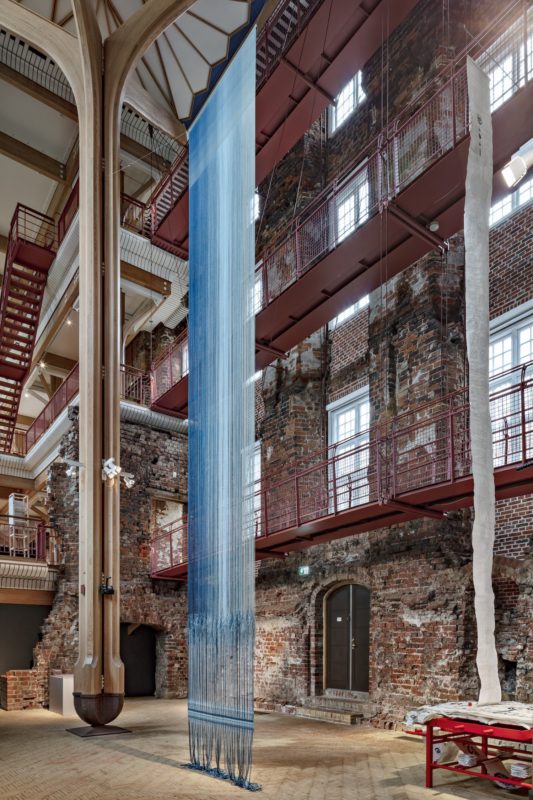Photo: Helle Trolle. Connected (Detail). Photo credit Dorte Krogh
This ambition of ‘socializing’ fibres so they can serve new purposes is reflected in the working process itself: textile production has always been a collective effort with a social aspect. Utilizing natural fibres by farming and shearing animals or growing and harvesting plants and then processing, spinning and transforming the fibres in countless ways has always required many hands and brought people together around a common goal. Throughout the centuries, most people, especially women, have mastered one or more methods for making textile. Shared traditions have emerged around all these joint activities: singing, storytelling, listening together as well as passing all the techniques on to new generations. Together, over the centuries, we have refined handed-down techniques and invented new ones.
With industrialization, textile production largely disappeared out of sight and moved inside hermetically sealed factory spaces where only paid employees had access. Today, many people are no longer initiated into all these traditions for handling textiles and do not learn to produce or repair them. In the span of just a few generations, many of these ancient skills have almost become extinct.
However, the social life of textiles is far from over. On the contrary. Today, many are picking up knitting needles or a sewing needle for the first time and learning the basics. Some do it in order to be self-reliant when it comes to maintaining their wardrobe and extending the lifetime of their clothes as a way of pursuing greater sustainability. Others discover that a craft can be a therapeutic activity that helps them relax. Both purposes give rise to new communities. Knitting and embroidery clubs are forming, there is a wide selection of craft courses and fairs on offer, and contemporary art is once again drawing inspiration from textiles and crafts.
Textiles continues to have a unique power to bring people together, as when Trapholt museum of modern art, craft and design invites its audience to contribute with elements to large artist-led collective works of art. Across borders, cultures and continents, craft can be a unifying factor, an shared field where it is easy and straightforward for everyone to learn from each other and exchange techniques. Craft makers go into the world to hone their skills, while newly arrived migrants can form new social connections through craft.
This is not even the first craft revival in our hypercomplex, late modern reality but the second. The first occurred during the 1970s and 1980s with the phenomenon of craftivism: slow craft became the basis of new forms of activism and stood in opposition to the consumer society, where a dizzying flood of textile products zip by us on their journey from production to short-lived consumption to waste. Craft became associated with feminism, anti-racism and anti-capitalism. All these alliances continue to exist to this day.
The growing interest in textile crafts as a source of culture and self-therapy is added affirmation of the eternal relevance of craft: the calm rhythms and patient construction of new structures become a way of self-transformation. By reclaiming our understanding of the characteristics and possibilities of textile, we are regaining our competence as creative human beings. And social structures are once again emerging around both types of activities. By learning to turn fabric or yarn into magical new forms, we are continuing textile history, which spans tens of thousands of years, and joining one of humanity’s oldest communities.
Keep Connected by Helle Trolle
Keep Connected is a textile web of loose threads in silk, wool and linen tied and woven together by Helle Trolle. The threads are dyed with dyes from indigo and aquatic plants by Helle Trolle’s colleagues:
Textile artist Hilde Hauen Johnsen, Norway: Author Catharina Ellis, USA, Researcher Pirita Lauiri, Alto University / Pasi Ainasoja, Finland: Textile artist Margaret Dugger, USA:
The indigo colors BOUISOU, Japan and by Helle Trolle herself. The work was made for the Biennale of Arts & Crafts & Design 2021. Koldinghus.
Photographer Dorte Krogh.

Helle Trolle. Koldinghus. Biennalen 2021.


